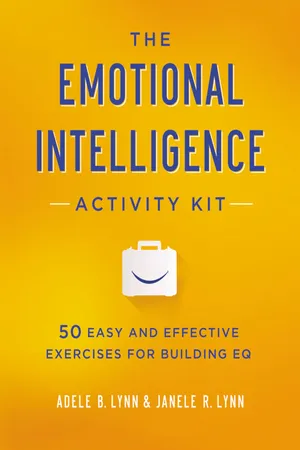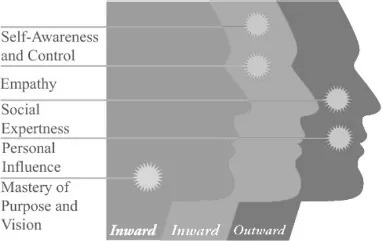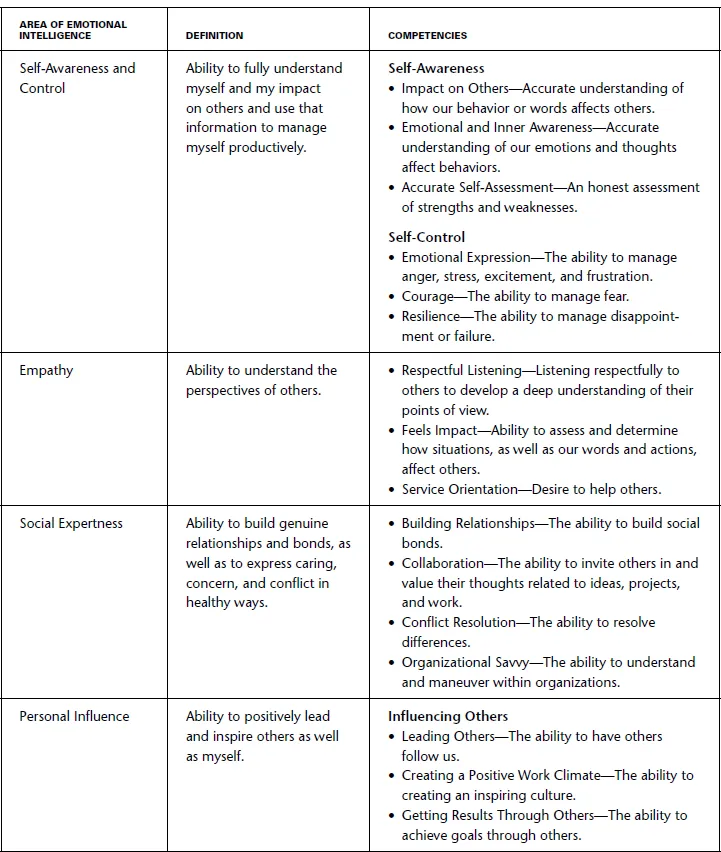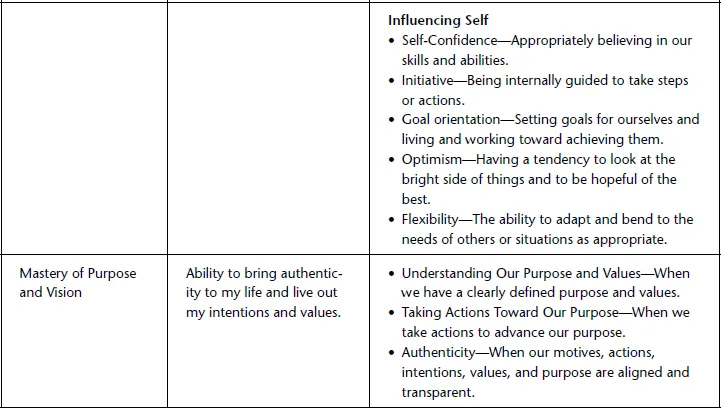CHAPTER 1
EMOTIONAL INTELLIGENCE—THE FRAMEWORK FOR GREAT PERFORMANCE
You’ve probably witnessed people in organizations who display great skill beyond traditional cognitive ability. More than likely, you have also witnessed people who, despite great cognitive capacity, demonstrate gaping deficiencies at work. These deficiencies could be attributed to a variety of factors, one of which is a lack of emotional intelligence. The theory that multiple types of intelligence exists has been recognized since 1983, when Howard Gardner published Frames of Mind: The Theory of Multiple Intelligences. Along the way, the term “emotional intelligence” was coined to describe competencies related to managing oneself and one’s interactions with others. Thirty years of research and ongoing debate have ensued about the definition of emotional intelligence and whether it even exists. Still, if you are a coach, trainer, or organizational development practitioner, your job comes down to helping people become more effective in their roles. In addition, you’ve come to appreciate that something other than cognitive skills is at play. In the learning and development field, emotional intelligence is widely accepted as a desirable element beyond cognitive skills for success in the workplace. This book is designed to give you practical ways to help others improve their emotional intelligence.
Studies show emotional intelligence competencies as a distinguishing factor in functions as diverse as sales, service, healthcare, productivity, profit, and even ethical decision making. Research that demonstrates the link between emotional intelligence and increased organizational performance are not hard to find. One study found that executives who scored high on Emotional Quotient (EQ) scales were more profitable than their peers and had a greater ability to express empathy and self awareness than their peers, who stood lower on the EQ scale. 1 Another study showed that businesses whose owners had a higher EQ earned greater revenues and experienced higher growth. The owners used their EQ to positively shape company culture. 2 As a predictor of performance, Druskat found that emotional intelligence is two times more accurate as a predictor of performance than cognitive intelligence, and it predicts success beyond an employee’s skill, knowledge, or ability. 3 Her work examined how teams and leaders effectively manage complex interpersonal and coordination challenges in cross-functional, cross-cultural, and self-managing work environments. Emotionally intelligent managers are responsible for a 34 percent greater annual profit growth, increased customer satisfaction, and higher retention, according to a 2003 study by Reuven BarOn and Geetu Orme. 4 Even ethical decisions, critical to the long-term success of any organization, were linked to emotional intelligence in a study of physicians and nurses. Higher EQ scores translated into decisions that were more ethical. 5 And, the more senior the leader, the more emotional intelligence matters. In a study of officers in the British Royal Navy, EQ competencies predicted overall performance and leadership better than any other predictive measures. This was especially true as the officer obtained higher rank. 6 For a comprehensive understanding of the research behind emotional intelligence, visit the Consortium for Research of Emotional Intelligence in Organizations.
A Lack of EQ—What Are the Challenges and How Do They Affect the Organization?
Lack of emotional intelligence can limit a person’s ability to get results. This inability can limit, derail, or halt careers. Here are some examples of how a lack of emotional intelligence can interfere with a person’s ability to deliver results:
• One leader was known for always telling people what to do. He had all the answers to all the questions all the time. He second guessed his executives’ decisions and freely told them what they were doing wrong. Besides annoying people with his arrogance, he eventually found himself inundated with details as others learned that if they didn’t involve him in a decision, he would find fault with it. His approach also cost him loyalty and turnover when several of his key executives left the company for other positions.
• Another leader was promoted to president of a large division, in which a key role was to maintain positive relationships with employees. Her predecessor had done this by constantly demonstrating his appreciation to employees. He had strong bonds with people at all levels of the organization, knew everyone by name, and engendered a genuine sense of caring and engagement. The new leader struggled. In fact, she avoided people. She even figured out which path to take to the ladies room so that she could see the fewest colleagues. Several months later, the employee engagement scores had tanked and turnover was at an all-time high.
• Another senior executive had an intense need to compete and win. He always wanted the biggest budget, the greatest span of control, and the last word. It actually cost him dearly in his relationships with his peers. Not until the CEO told him that these behaviors were the reason he was not considered for promotion did he pay attention to the cost and consequences of this behavior.
• A senior leader continually created tension among her peers by always reacting with skepticism to new ideas. Although contrary opinions and evidence are useful in decision making, someone who constantly reacts with skepticism will find it is draining and damaging to relationships. It also gives the person a label that she may not want to have.
• A leader lost his job when his new boss became tired of hearing him make excuses. His favorite excuse was, “We can’t control business conditions.” The new boss’s favorite expression was, “We create our own business conditions by steering the business in the direction of opportunity.”
The leaders in these examples are real. Each failure can be traced back to an emotional intelligence-related competency. Each leader suffered a career consequence because of a lack of emotional intelligence. More importantly, each leader had the ability to successfully recognize and overcome his or her failure and increase emotional intelligence competency.
However, leaders are not the only ones who suffer career consequences related to limited emotional intelligence. Everyday people are inadvertently sabotaging their careers with these types of behaviors:
• The IT person who, once again, has offended the customer.
• The call center worker who rarely can deescalate the conflict and, so, requires the supervisor’s time and effort.
• The engineers who intensify the never-ending email battles for the sake of proving themselves right.
• The coworkers who are so involved in the daily cat fight that they miss the fact that they are actually being paid to work.
• The healthcare worker who is so caught up in the daily “who should be doing what” argument that important health details are not communicated.
And, no doubt, each of these persons may be right about something. However, their methods of interaction may be flawed. It’s the methods that encompass the emotional intelligence failure. Although all of these actions may invoke an individual career penalty, ultimately, the organization suffers the consequence. Moreover, the consequences can be costly. Lost customers, lost time, the best solution giving way to ego, or even medical mistakes, can all result from EQ failures. Otherwise talented individuals misdirect their time and expertise, and the businesses and individuals both lose. The challenge of EQ failures begs for a solution. Coaching and training offer part of that solution.
Development professionals can provide an essential service to the organization by enhancing the emotional intelligence of the workforce. This book offers the “how.”
A Working Definition of Emotional Intelligence
The definition of emotional intelligence is “the ability to manage ourselves and our relationships with others so that we can live our intentions and reach our goals.” 7 This definition, and the competencies that follow, offer a practical model for emotional intelligence. In addition, the activities in this book make the definition and competencies actionable for adults in the workplace, which is the focus of this book.
The first part of the definition (“the ability to manage ourselves”) clearly centers on with the individual. Common language requires people who are emotionally intelligent to be aware of their emotions and be able to self-manage, self-regulate, or exercise self-control. The second part of the definition (“the ability to manage our relationships with others”) requires that people be aware of the impact they have on others, so that they can productively manage the relationships that life requires. In the world of work, those relationships are with employees, peers, customers, vendors, supervisors, and other people with whom we interact. If those relationships do not function successfully, productivity, morale, retention, and costs will be negatively affected. The definition continues with “live our intentions and reach our goals.” From the point of view of an organization, living with intention equates to acting in alignment with the organization’s values. Finally, an organization sets goals to be achieved. Of course, the definition can be applied outside of the organizational context. If so, living our intentions and reaching our goals would imply living and exercising our personal values and reaching the goals/purpose that we have set for our lives.
Five Areas of Emotional Intelligence
Our model for emotional intelligence includes five areas: self-awareness and control, empathy, social expertness, personal influence, and mastery of purpose and vision (see Figure 1-1). 8 Within these five areas, several specific competencies emerge (see Figure 1-2). Definitions and competency descriptions of the five areas follow.
1. Self-Awareness and Control. The ability to fully understand ourselves and use that information to manage emotions productively. This area includes the competencies of accurate understanding of our emotions and the impact emotions have on performance, accurate assessment of strengths and weaknesses, understanding our impact on others, and self-management or control, including managing anger, disappointment or failure (resulting in resilience), and fear (resulting in courage).
2. Empathy. The ability to understand the perspective of others. This area includes the competencies of listening to others, understanding others’ points of view, understanding how our words and actions affect others, and wanting to be of service to others.
FIGURE 1-1 Five Areas of Emotional Intelligence
FIGURE 1-2 Emotional Intelligence Table of Competencies
3. Social Expertness. The ability to build genuine relationships and bonds and express caring, concern, and conflict in healthy ways. The competencies of relationship building, organizational savvy, collaboration, and conflict resolution are included in this area.
4. Personal Influence. The ability to positively lead and inspire others, as well as ourselves. Leading others, creating a positive work climate, and getting results from ...



